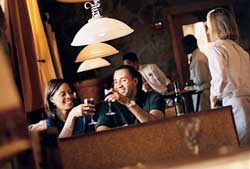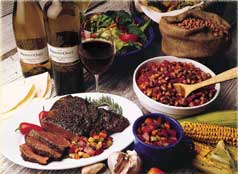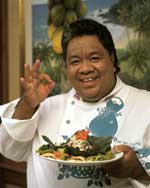
California, with its mild climate and fertile soil, produces more asparagus, avocados, broccoli, carrots, grapes, lettuce, olives, pears and wine than any other state in the Union.
The state's rich immigrant history has led to the creation of many great foods. Early Italian Americans started cheese businesses, developed the region's fishing industry and built many of the wineries. Chinese immigrants worked the shrimp boats, opened restaurants and established Chinatown communities in most of the big cities in California, including the largest such area in San Francisco. In addition, Hispanics have opened numerous groceries, restaurants and food manufacturing companies.
California leads the country in food and wine trends. In fact, contemporary cooking began here. The approach to cooking is described as multicultural (ingredients and techniques). Fusion cuisine, ready-mixed green salads, and vegetable burgers are trends that started in California.

Artisan Breads to Pizza
At one time, Wonder Bread was the best-selling bread in America. In fact, most of the country went through a phase of preferring convenient foods to quality. During the 1970s, a handful of artisan bakers in Berkeley, Calif., began to reverse that preference. In the process, they began the bread craze by making some of the best baguette, focaccia, panini, ciabatta and sourdough breads outside of Europe. They used the finest ingredients available, but cooked the Old World, hearth-baking way, in which bread is baked directly on the oven floor rather than in a pan. Today, bakery cafes, using artisan bread-making techniques as their marketing niche, have popped up across the country.In 1985, one of the first gourmet pizza restaurants opened in Beverly Hills, Calif. California Pizza Kitchen (CPK) (Los Angeles) was the first pizza restaurant to offer unique, international pizza topping flavors with California flair. Flavors included barbecue chicken, Portobello mixed mushroom, and Thai chicken. Some 18 years later, the chain has 116 restaurants in 26 states, the District of Columbia and four foreign countries.
With the success of the chain, CPK formed a strategic alliance with Kraft Pizza Company, a subsidiary of Kraft Foods Inc. (Glenview, Ill.), to distribute a line of premium frozen pizzas through supermarkets and retail outlets. Initially, six flavors were introduced to the retail market. Two of the original flavors remain on shelves. The Barbecue Chicken Pizza is made with white chicken, a spicy-sweet barbecue sauce, red onions, smoked Gouda and mozzarella cheeses. The Rosemary Chicken-Potato Pizza is made with garlic chicken blended with a Bordelaise butter sauce made with white wine, rosemary and lemon and roasted rosemary potatoes.

Olives and Organics
Spanish missionaries, who journeyed to California over two centuries ago, planted olive trees. Today, the state boasts over 35,000 acres of olive groves. California canneries produce about three-quarters of the ripe olives consumed in the U.S. The olives are picked green, lye-cured to remove the natural bitterness, then “oxygenated” to turn them from green to black.The California Olive Oil Council (Berkeley, Calif.), established a certification program to ensure that California olive oils are labeled correctly and meet international standards.
Long before the Food and Drug Administration—FDA (Rockville, Md.) devised the official organic labeling guidelines last fall, 50 farmers founded the California Certified Organic Farmers—CCOF (Santa Cruz, Calif.). The group was founded 20 years ago to address concerns about pesticide residues on foods and has grown to include several hundred members. As a result of this movement, supermarket chains such as Wild Oats (Boulder, Colo.) and Whole Foods Market (Austin, Texas) specialize in all types of organic items.
One of the fastest-growing companies catering to the all-natural/organic niche is Amy's Kitchen (Santa Rosa, Calif.), which reported 2001 sales of over $100 million. Founded in 1987 by Andy and Rachel Berliner, the goal was "to create healthy eating for busy people." Today, the chain is the nation's leading source of frozen organic, prepared foods, holding 70% of the organic frozen market.
More than 80 natural and organic products can be found in store aisles—about 80% are frozen entrees, pizzas and convenience foods, while the remaining 20% are canned soups, chilies and jarred sauces. All of Amy's Kitchen products are compliant with the new USDA national organic standards. Many of the products are lactose-, cholesterol- and gluten-free, as well as non-dairy and fit for vegans.
Among Amy's products is a California vegetable burger, made with a blend of grains, organic vegetables, mushrooms and walnuts. Their tofu vegetable lasagna is made with tofu and soy cheese.
Many California chefs are using everything organic to make up their menus. Celebrity chefs such as Alice Waters and Wolfgang Puck have helped steer this trend over the years.
Alice Waters, executive chef and owner of the restaurant Chez Panizze (Berkeley, Calif.), is interested in knowing the origin of the foods used in her menus and how they are grown. Before using pork products, she ensures that ranchers use only organic feed for their pigs. No fan of genetically modified foods, Waters likes eating and serving tomatoes on her menu only three months out of the year, during the growing season. Chez Panisse opened its doors over 30 years ago, and Waters has been one of the biggest crusaders for organic eating. She has cultivated a network of 60 local organic growers, ranchers, cheese makers and vineyards, which supply her with the freshest products.
Chez Panisse ranks as one of the best restaurants in the country. Menus are a la carte and change daily. Example items include local chanterelle and onion galette with arugula salad, braised Niman Ranch lamb shank with anchovy gremolata and saffron risotto, candied orange ice cream profiteroles with caramel sauce.
Another well-known chef, Wolfgang Puck, is credited for reviving California's rich and varied culinary heritage by blending fresh California ingredients and classical French training. Puck says, “California cuisine is a cooking expression of Asian, Italian and Latin cultures and influences.” His innovative cooking style has been implemented in more than 25 food products. Pizzas are his line's trademark products and, for years, were the most requested items at his Spago restaurants across the country. The frozen retail versions are made from the original restaurant recipe, using 100% all-natural ingredients and hand-stretched dough; the items contain no chemicals or preservatives.
About a year ago, Wolfgang introduced a line of soups. He says the tomato-flavored soup leads the line in sales. A frozen "wooden fire" pizza currently is in development and is expected in stores soon.
Another fast-growing brand is Tulocay and Company's Made in Napa Valley (Napa, Calif.), founded by Catherine Bergen. She started the company two years ago, and now the company is well known for excellent, world-class wine. Additionally, the company offers a high-quality, gourmet line of more than 40 food products, each made with all-natural ingredients.
The artichoke with orange and chardonnay condiment is made with chucks of fresh artichokes, blended with onions, zesty orange peel, chardonnay wine and olive oil. A roasted corn and red bell pepper condiment is made with fresh corn kernels, summer-ripe peppers, champagne vinegar, premium olive oil, garlic, lime juice and fresh garden herbs and spices.
Other products in the line include a variety of savory tomato sauces, dressings, dipping oils, rubs, mustards, fruit condiments, dessert sauces, tapenades and baking mixes.

More Pacific Pleasures
Going further west, one is entranced by the exotic Hawaiian Islands, located in the middle of the Pacific Ocean, halfway between Asia and the U.S. mainland. Cooking styles popular in the islands come from layers of multicultural influences.Centuries ago, the Polynesians were the first to arrive on these volcanic islands that emerged from the Pacific Ocean. They brought with them plants and seeds to grow taro (a tuber-shaped, starchy plant that has a brown skin, gray-white flesh and an acidic flavor when eaten raw, and tastes nutty when cooked), bananas, coconuts, sweet potatoes and sugar cane. They also brought their traditional technique of pit cooking. This kind of cooking evolved into what is now called Laua, which requires a pit to be dug and lined with wood and lava rocks. After the wood is burned and the rocks become red hot, a layer of banana tree stumps are placed in the pit to create steam that protects the food from burning by contact with the rocks. Then, a large pig is stuffed with the hot rocks and lowered in the pit. The pig is covered with burlap, canvas and earth, then cooked all day. Laua is still popular today, but not as commercialized. In fact, many restaurants and meat manufacturers no longer practice this kind of cooking.
As time progressed, other groups such as the Japanese, Chinese, Filipinos and Koreans settled on the Hawaiian Islands, each culture contributing its own ingredients and cooking styles. The Japanese used wasabi, ginger and soy ingredients, and cooked with hibachi grilling techniques. Chinese cooks utilized chili peppers, rice, soy sauce, cinnamon, fennel seeds and star anise, and introduced stir-fry cooking. The Filipinos used ginger, lemongrass and annatto seeds. The Koreans introduced pickled cabbage, kimchi. From all of these rich multicultural backgrounds and influences, popular Hawaiian appetizer combo platters, containing a variety of items such as dim sum, Korean meatballs, marinated and grilled beef & pork, and sushi, are served in many of the local restaurants.
Because of its year-round tropical weather, macadamia nuts, coffee (Kona), pineapples, bananas and carambola (star fruit) are major sources of the state economy. Fruits such as strawberry guavas, papayas and coconuts are so plentiful, they grow wild. A few years ago, the carambola fruit could only be found in gourmet ethnic neighborhood markets. Now, it is sold in most mainstream grocery stores.
Another fruit that holds an important place in Hawaiian cooking is breadfruit, which is related to the fig family and quickly is gaining popularity. Polynesians brought breadfruit plants from Tahiti to Hawaii. It has a bumpy green skin, cream-colored flesh with the texture of fresh bread and a bland flavor. It contains about the same amount of carbohydrates (sugar and starch) as taro and sweet potatoes. When ripe, the starch changes to sugar. It is usually cooked the same way as white or sweet potatoes—baked, boiled, creamed, fried, mashed, puréed, roasted or steamed. Hawaiian dishes feature breadfruit in soups, puddings and cakes.
Hawaii's Culinary Ambassador
Chef Sam Choy has been given the official honorary title of Hawaii's “Culinary Ambassador” by the Big Island mayor. He describes his native cuisine as a melting pot of the freshest ingredients gathered from every culture on all the islands in Hawaii. Chef Choy says, “Basically, when you look at Hawaii, you see our surroundings. Our front porch is the continental U.S., and our back door is Asia. Hawaii is a melting pot and the different cultures that reflect the food—all on one plate.” However, freshness is very important to him. Television producer Rochelle Brown—of the Emeril Live show and author of The Chef, the Story and the Dish, (Stewart Tabori & Chang, 2002), shares a story in her new cookbook about how Chef Choy insisted on bringing the popular Hawaiian fish Mahi Mahi, which weighed 150 lbs., with him to cook on the show with Emeril.Chef Choy currently is working with ConAgra Frozen Foods (Omaha, Neb.) to develop a line of frozen products. He already has a line of sauces that are successful. The flavors are Creamy Oriental Dressing, Spicy Oriental Vinaigrette & Marinade, Wasabi Vinaigrette & Marinade, and a Creamy Wasabi Oriental Dressing. In addition, Chef Choy has nine top-selling cookbooks under his belt, reflecting Hawaiian cooking, and three popular restaurants, two in Hawaii and one in Guam.
Hawaiian influences also are traveling to the mainland in the form of processed foods. The King's Hawaiian (Torrance, Calif.) company is based in California, but its roots are deep in Hawaiian culture. For over 50 years, King's Hawaiian has produced fresh baked goods, including its signature product, the original recipe King's Hawaiian Bread, a round Portuguese sweet bread, and honey multigrain bread and dinner rolls, sold in every major supermarket across the country. Recently, King's Hawaiian expanded into the frozen entrée business. The product line includes a spicy chicken peanut bowl, teriyaki chicken bowl, chicken fried rice, and sweet and sour chicken. These entrée flavors are examples of the melting pot flavors of Hawaii.
Haute Hawaii
For more than a decade, Chef Roy Yamaguchi has spotlighted the ingredients and growers of Hawaii on his public television show. As a classically trained chef, Yamaguchi combines fresh, local Hawaiian ingredients with French cooking techniques to produce signature foods. Examples include crab and taro cakes with Béarnaise sauce, lamb steaks with sweet potato mash and apple-curry sauce, roast pork with caramelized pineapple, and Lilikoi (passion fruit) Pudding Cake. In 1988, Chef Roy opened his first restaurant in Honolulu. In 1999, he teamed up with the Outback Steak house chain and started a joint venture, which today, has increased to over 30 restaurants around the world, serving the finest Hawaiian flavors. At the retail level, Chef Roy has a line of coffee (including kona) and a sizable line of private label wines—several are used in the restaurants to complement the menu. Many ingredients, such as seafood, fruits, and vegetables are flown daily from Hawaii to his restaurants across the world. Chef Roy rec ently completed his cookbook, Hawaii Cooks: Flavors from Roy's Pacific Rim Kitchen (Ten Speed Press, 2003).
Whether enjoying the nouvelle cuisine California offers, or the traditional seafood and fruit dishes of Hawaii, a traveler has many delicious options to choose from. This is all part of what is generally referred to “Pacific Rim” cuisine, a grouping of foods that is as complex and nuanced as any cuisine in the world.
Website Resources
www.ccof.org— California Certified Organic Farmerswww.wolfgangpuck.com— Wolfgang Puck
www.samchoy.com— Sam Choy
www.roysrestaurant.com- Roy Yamaguchi
http://suresave.com/hawaiikitchen/hawaiikitchen.html— A variety of Hawaiian recipes